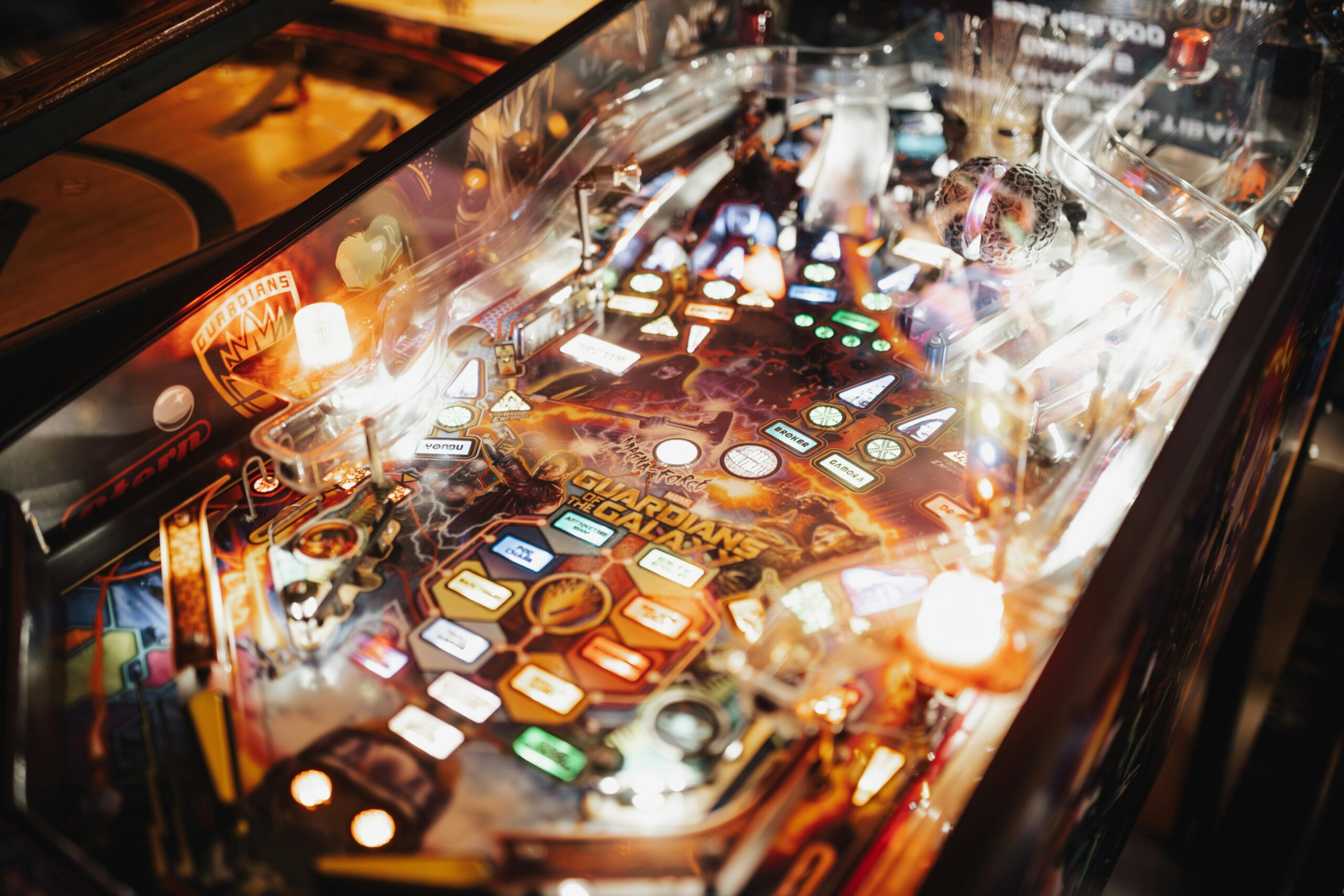Pinball, a game of skill, reflexes, and mechanical artistry, has captivated players for nearly a century. From its origins in coin-operated amusement arcades to its resurgence as a collector’s passion and domestic entertainment centrepiece, pinball’s history is one of innovation, cultural shifts, and enduring appeal. This article explores the evolution of pinball and pinball tables, their technological and cultural development, and their growing popularity in UK homes.
The History of Pinball
Early Origins: Pre-Pinball Games (18th–19th Century)
Pinball’s roots trace back to 18th-century Europe, where games like bagatelle, a precursor to modern pinball, emerged. Bagatelle, popular in France and the UK, involved players using a cue to propel balls across a slanted wooden board with pins and holes, aiming to score points by landing balls in specific targets. By the 19th century, bagatelle tables were common in British pubs and aristocratic homes, costing a penny or two to play in public venues. These early games relied on gravity and lacked flippers, making them more luck-based than skill-driven.
In the late 1800s, mechanical amusement devices proliferated in the UK, particularly in seaside resorts like Blackpool and Brighton. Coin-operated bagatelle variants, alongside strength testers and mutoscopes, formed the backbone of penny arcades, setting the stage for pinball’s development.
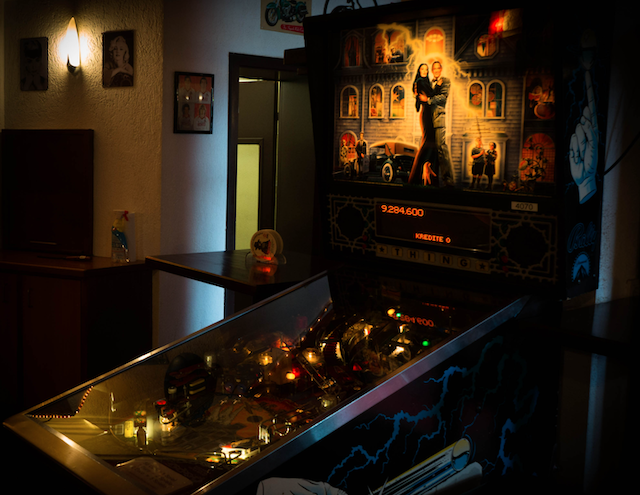
The Birth of Pinball: 1930s–1940s
Modern pinball emerged in the United States during the Great Depression, driven by innovations in electromechanical technology:
- First Pinball Machines: In 1931, Baffle Ball by Gottlieb introduced a coin-operated, tabletop game with a spring-loaded plunger to launch a ball onto a pin-studded board. Costing $17.50 (£350 in 2025 terms), it was a hit in US bars and arcades, with UK imports following by 1932.
- Electrification: By 1933, machines like Contact by Pacific Amusements added electric scoring via contact points, replacing manual scorekeeping. These early tables cost 1d–2d per play in the UK.
- Flippers Introduced: In 1947, Gottlieb’s Humpty Dumpty introduced flippers, transforming pinball into a skill-based game. Players could now control the ball, extending playtime and engagement. UK arcades adopted flipper-based machines by the late 1940s, priced at 6d per game.
Pinball’s early years in the UK were tied to seaside arcades and urban entertainment venues. However, its association with gambling led to regulatory scrutiny, with some councils restricting machines in the 1940s due to concerns over youth delinquency.
The Golden Age: 1950s–1970s
The post-war period marked pinball’s peak popularity:
- Technological Advances: Electro-mechanical (EM) pinball machines dominated, featuring relays, solenoids, and score reels. Games like Kings of Steel (1957) and Gigi (1960) by Gottlieb introduced complex scoring and multiball modes. Tables cost £500–£1,000 to manufacture (equivalent to £10,000–£20,000 in 2025).
- Cultural Impact: In the UK, pinball machines proliferated in cafes, arcades, and bowling alleys, costing 6d–1s per play. Iconic venues like London’s Trocadero housed dozens of tables, attracting teenagers and young adults.
- Thematic Designs: Machines adopted vibrant themes, from sci-fi (Space Mission, 1976) to sports (Strike Zone, 1970). Artwork, hand-painted by artists like Roy Parker, became a hallmark, enhancing collectability.
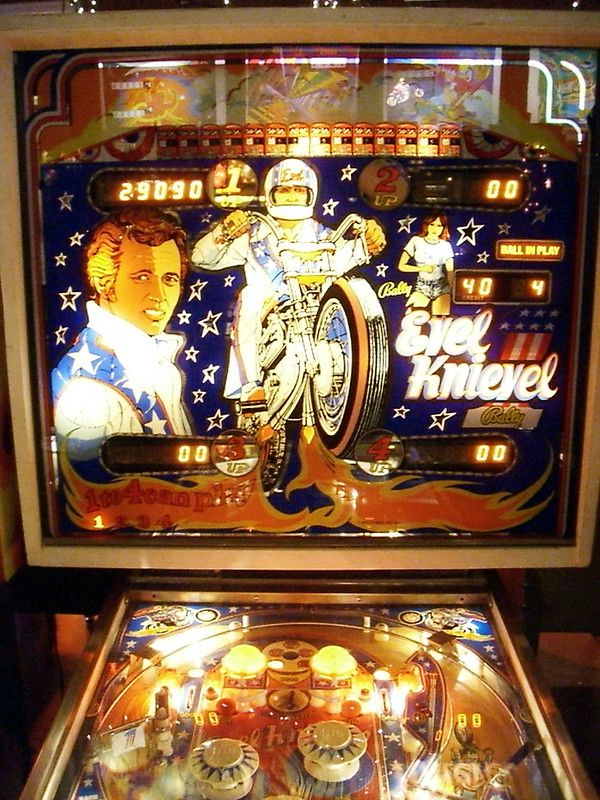
The Video Game Challenge: 1980s–1990s
The rise of video arcade games in the late 1970s, such as Space Invaders (1978) and Pac-Man (1980), threatened pinball’s dominance:
- Solid-State Revolution: Pinball adapted with solid-state electronics, introduced in 1977 with games like Eight Ball by Bally. Microprocessors enabled complex rules, speech synthesis, and digital displays. Tables like Black Knight (1980) and Firepower (1980) offered innovative features like ramps and multiball, costing £2,000–£4,000 per unit (£7,000–£14,000 in 2025).
- Cultural Shifts: In the UK, pinball remained popular in arcades but faced competition from video games and home consoles like the Atari 2600. By the 1990s, many arcades closed, and pinball’s presence dwindled. Games cost 20p–50p per play.
- Iconic Titles: The 1990s produced legendary machines like The Addams Family (1992) by Bally, the best-selling pinball table of all time (20,270 units), and Twilight Zone (1993) by Williams, known for complex gameplay. These tables cost £3,000–£5,000 new (£6,000–£10,000 in 2025).
Decline and Revival: 2000s–2010s
Pinball faced near extinction in the early 2000s:
- Industry Collapse: Major manufacturers like Williams and Bally exited pinball production by 1999, focusing on slot machines. Stern Pinball (founded 1999) became the primary producer, keeping the industry alive.
- Nostalgia and Resurgence: By the 2010s, nostalgia fuelled a pinball revival. Boutique arcades, such as Arcade Club in Bury, UK, showcased restored machines, charging £10–£20 for unlimited play. Collectors and enthusiasts formed communities via forums like Pinside and the UK Pinball Group.
- New Manufacturers: Companies like Jersey Jack Pinball (2011) and Spooky Pinball (2014) entered the market, producing high-end machines with LCD screens and licensed themes (e.g., Wizard of Oz, 2013). UK-based Heighway Pinball briefly operated, launching Full Throttle (2015) before closing in 2018.
Pinball Tables in 2025
Types of Pinball Tables
- Electro-Mechanical (EM) Tables:
- Design: Pre-1977 machines with mechanical relays, score reels, and simple rules. Examples include Fireball (1972) and Wizard (1975).
- Availability: Restored EM tables are collectibles, available through UK specialists like Pinball Heaven or eBay.
- Price: £1,500–£4,000, depending on condition and rarity.
- Appeal: Nostalgic charm and simpler gameplay attract collectors, though maintenance is intensive due to mechanical parts.
- Solid-State Tables:
- Design: 1980s–1990s machines with microprocessors, digital scoring, and complex rules. Examples include The Addams Family and Medieval Madness (1997).
- Availability: Second-hand units dominate the UK market, sourced from arcades or collectors.
- Price: £3,000–£7,000 for popular titles; rare machines like Cactus Canyon can exceed £10,000.
- Appeal: Balanced complexity and iconic themes make these a favourite for enthusiasts.
- Modern Digital Tables:
- Design: Post-2010 machines with LCD screens, RGB lighting, and licensed themes (e.g., Stranger Things or Jurassic Park by Stern). Features include video modes, Bluetooth connectivity, and up to 100+ rules.
- Manufacturers: Stern Pinball dominates, with American Pinball and Jersey Jack Pinball offering premium models. Chicago Gaming Company produces remakes of classics (e.g., Medieval Madness Remake).
- Price: New machines cost £6,000–£12,000 (Stern Pro models at £6,000–£8,000, Premium at £8,000–£10,000, Limited Editions at £10,000–£12,000). Jersey Jack tables start at £9,000.
- Appeal: Cutting-edge technology and pop culture themes attract modern buyers.
- Virtual Pinball Tables:
- Design: PC-based machines with large LCD screens simulating pinball playfields. They emulate thousands of tables via software like Visual Pinball or Pinball FX.
- Price: £2,000–£5,000, depending on screen size and cabinet quality.
- Appeal: Affordable and versatile, offering access to hundreds of games in one unit, though lacking the tactile feel of physical tables.
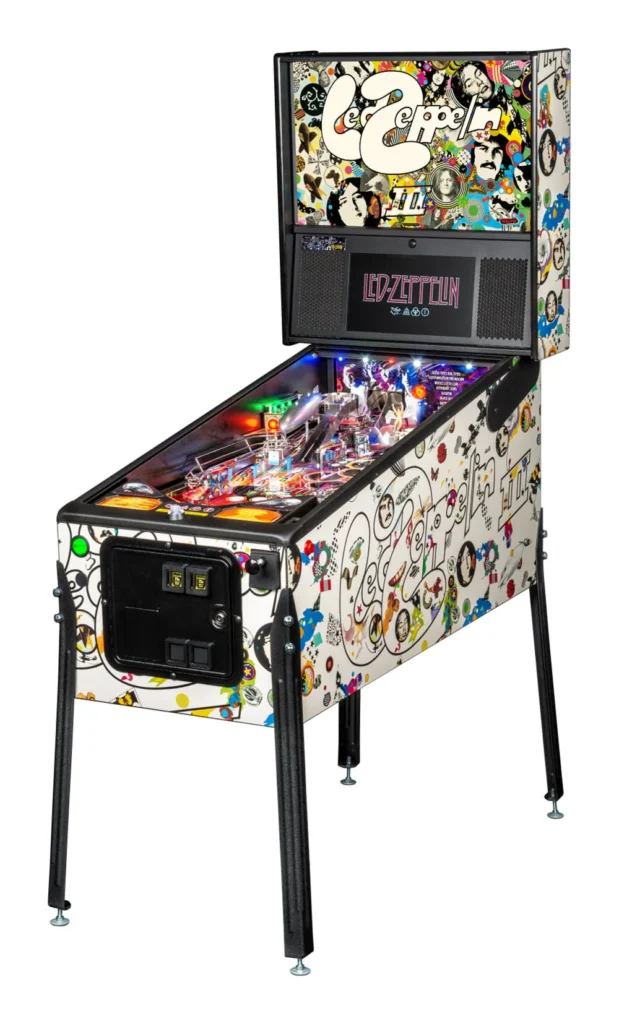
Technology in 2025
- Hardware: Modern tables use solid-state electronics, high-resolution LCDs (up to 27 inches), and modular components for easier repairs. RGB LEDs enable dynamic lighting, and speakers deliver immersive soundtracks.
- Software: Proprietary operating systems (e.g., Stern’s Spike 2) support complex rules and firmware updates. Some machines offer Wi-Fi for online leaderboards and remote diagnostics.
- Construction: Steel playfields, tempered glass tops, and hardwood or MDF cabinets ensure durability. A standard table measures 1.4m long, 0.7m wide, and 1.9m tall, weighing 100–150kg.
- Maintenance: Modern tables require minimal upkeep (e.g., cleaning playfields, replacing rubbers every 1–2 years at £20–£50). EM tables need frequent repairs (e.g., relay cleaning, £50–£200).
Commercial Landscape
- Arcades: UK venues like Arcade Club (Bury, Leeds) and Pinball Republic (London) offer dozens of machines, charging £10–£20 for unlimited play. Seaside arcades in Blackpool and Brighton maintain pinball alongside video games.
- Tournaments: The UK Pinball League and International Flipper Pinball Association (IFPA) host competitive events, with top players competing for world rankings.
- Challenges: High maintenance costs and space requirements limit pinball’s presence in smaller arcades, but dedicated venues thrive on enthusiast support.
Pinball Tables in the Modern UK Home Setting
Popularity and Market Trends
Pinball tables have carved a niche but passionate following in UK homes, driven by nostalgia, collectability, and the rise of dedicated games rooms. While less common than pool tables or arcade machines due to their cost and complexity, pinball tables appeal to enthusiasts, collectors, and affluent homeowners. In 2025, the UK domestic pinball market is growing, with retailers reporting 15–20% annual sales increases since 2020, fuelled by:
- Nostalgia: Players aged 40–60, who enjoyed pinball in the 1980s, seek to recapture arcade experiences.
- Collector Culture: Pinball’s status as a collectible, with rare tables appreciating in value, attracts investors. For example, a restored The Addams Family purchased for £3,000 in 2010 may now fetch £6,000–£8,000.
- Social Appeal: Pinball tables serve as conversation pieces in homes, offering tactile, multiplayer fun for parties or family gatherings.
- Community: Online forums (Pinside, UK Pinball Group) and social media platforms like X connect UK enthusiasts, sharing setup tips and restoration advice. Events like Play Expo Manchester showcase domestic pinball setups.
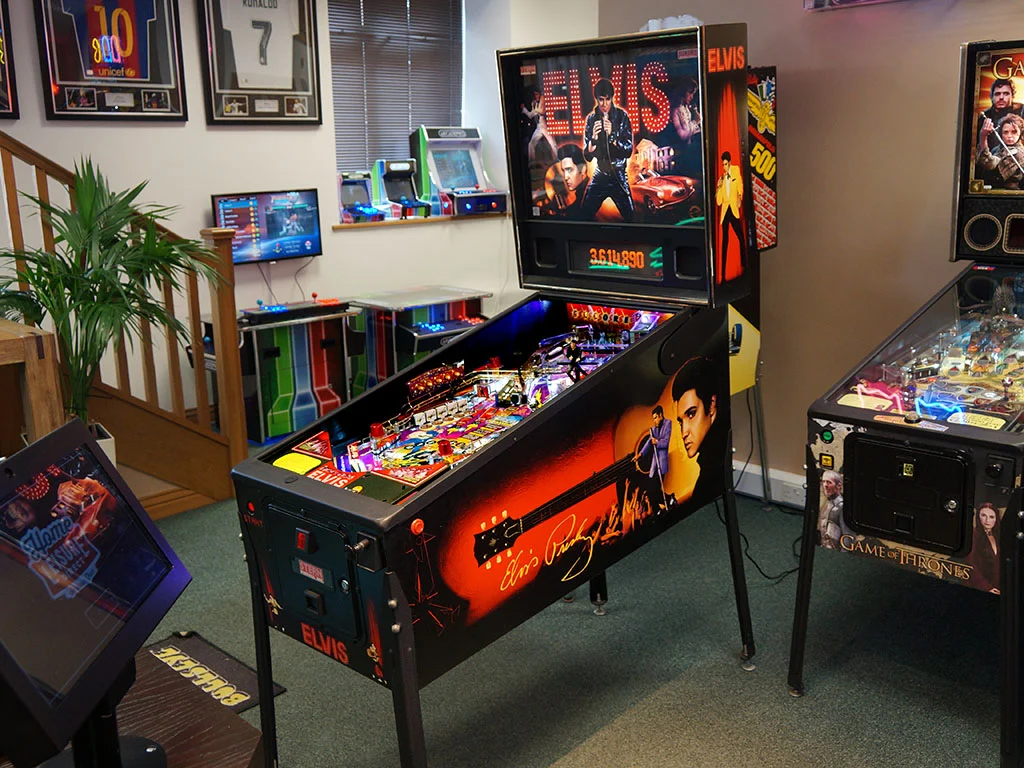
Types and Costs
- Restored EM and Solid-State Tables:
- Popularity: Collectors favour 1970s–1990s machines for their historical value and gameplay. Titles like Creature from the Black Lagoon (1992) or Fish Tales (1992) are sought after.
- Cost: £1,500–£4,000 for EM tables; £3,000–£10,000 for solid-state models. Rare titles or pristine restorations can reach £15,000.
- Considerations: High maintenance (e.g., £100–£500 for repairs) and limited game variety (one table, one game) deter casual buyers.
- New Digital Tables:
- Popularity: Stern’s modern machines dominate, with models like Godzilla (2021) or Rush (2022) popular among affluent buyers. Limited Editions sell out quickly via pre-orders.
- Cost: £6,000–£12,000, with accessories (e.g., toppers or side art, £100–£500) adding to costs.
- Considerations: High playability and low maintenance appeal to serious players, but prices limit mass adoption.
- Virtual Pinball Tables:
- Popularity: Growing among budget-conscious buyers and those with limited space, offering hundreds of emulated tables.
- Cost: £2,000–£5,000, with DIY builds as low as £1,000 using Raspberry Pi or PC hardware.
- Considerations: Affordable and versatile but lacks the authentic feel of physical tables, making them less appealing to purists.
Space and Installation
- Room Requirements: A standard pinball table requires a 2m x 1.5m space, including room for player movement. Multiple tables need a dedicated games room (e.g., 4m x 4m for two tables). Urban flats often limit ownership to virtual tables.
- Installation: Tables weigh 100–150kg, requiring professional delivery (£50–£200) and levelling. UK retailers like Pinball Heaven and Home Leisure Direct offer setup services (£100–£300).
- Power: Standard 240V UK outlets suffice, with machines consuming 200–400W.
- Lighting: Overhead LED lighting (£50–£200) enhances visibility and aesthetics.
Cost Considerations
- Entry-Level (£1,500–£4,000): Restored EM tables or basic virtual pinball units suit budget-conscious collectors or casual players.
- Mid-Range (£4,000–£8,000): Solid-state tables or entry-level Stern Pro models appeal to enthusiasts with moderate budgets.
- High-End (£8,000–£15,000+): Premium Stern or Jersey Jack machines, remakes, or rare classics target affluent collectors.
- Additional Costs: Delivery (£50–£200), maintenance (e.g., playfield waxing, £20–£50 annually), and accessories (e.g., anti-glare glass, £200) add to expenses. Restored tables may require £100–£500 in repairs every 2–5 years.
Trends in 2025
- Licensed Themes: Modern tables feature popular franchises (e.g., Marvel’s Venom, The Mandalorian), appealing to younger buyers. Stern’s 2025 releases include music-themed tables like Metallica Remastered.
- Smart Features: Wi-Fi connectivity, online leaderboards, and mobile apps for tracking scores or maintenance schedules are standard in new machines.
- Customization: Buyers can add custom toppers, powder-coated armour, or LED mods (£100–£1,000). UK retailers offer bespoke cabinet decals.
- Eco-Conscious Designs: Manufacturers use sustainable materials (e.g., recycled plastics) and energy-efficient LEDs, aligning with UK environmental trends.
- Virtual Pinball Growth: Affordable virtual tables are gaining traction in urban homes, with 4K screens and haptic feedback improving immersion.
Cultural and Social Factors
- Games Rooms: The trend for dedicated home entertainment spaces, particularly in suburban homes or converted garages, boosts pinball ownership. A 2024 UK survey by Home Leisure Direct noted 25% of games room owners include a pinball table.
- Urban vs. Rural: Urban buyers (e.g., London, Manchester) favour virtual tables due to space constraints, while rural homeowners with larger properties invest in physical tables.
- Community Engagement: UK pinball enthusiasts connect via X, sharing photos of home setups (e.g., “#PinballUK” posts) and organizing local meetups. The UK Pinball Party in Daventry attracts hundreds annually.
- Resale Value: High-quality tables retain value, with 1990s classics appreciating 5–10% annually. A Medieval Madness bought for £5,000 in 2015 may now sell for £8,000–£10,000.
Challenges and Limitations
- Cost: High prices (£6,000–£12,000 for new tables) limit pinball to affluent buyers or dedicated collectors.
- Space: Standard tables require significant room, challenging in average UK homes (80m² for flats).
- Maintenance: EM and solid-state tables need skilled repairs, with parts scarce for pre-1980s machines. Virtual tables are low-maintenance but less authentic.
- Competition: Home consoles, VR gaming, and mobile apps offer cheaper alternatives, though pinball’s tactile appeal remains unique.
Retail and Community
- Retailers: UK specialists like Pinball Heaven (Staffordshire), Home Leisure Direct (Bristol), and Liberty Games (London) offer new and restored tables, with showrooms for testing. Online platforms like eBay and Pinball Trader cater to second-hand buyers.
- Second-Hand Market: Restored tables retain 60–80% of original value, with popular models selling quickly on forums or X marketplaces.
- Community: The UK Pinball Group (500+ members) and social media hashtags like #UKPinball foster a vibrant community, with collectors sharing restoration tips and tournament news.
Conclusion
Pinball’s journey from 19th-century bagatelle to 2025’s high-tech tables reflects a blend of mechanical ingenuity and cultural nostalgia. From the electromechanical wonders of the 1950s to modern digital machines with LCD screens and licensed themes, pinball tables remain a testament to tactile gaming. In UK homes, pinball’s popularity is growing, driven by collectors, enthusiasts, and the trend for games rooms. While costs (£1,500–£15,000) and space requirements limit mass adoption, affordable virtual tables and a passionate community ensure pinball’s place in modern domestic settings. Whether a restored The Addams Family or a new Stern Godzilla, pinball tables offer a unique blend of skill, art, and nostalgia, making them cherished additions to UK homes.

